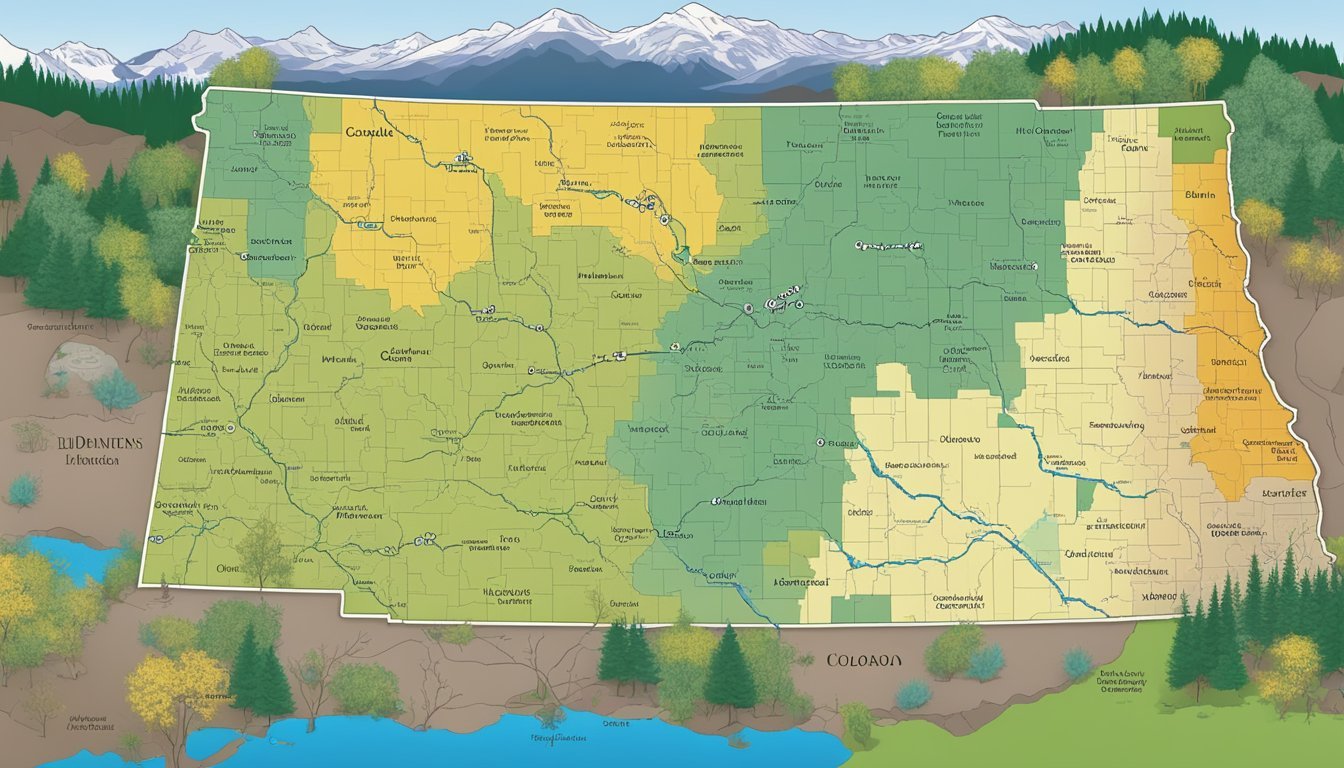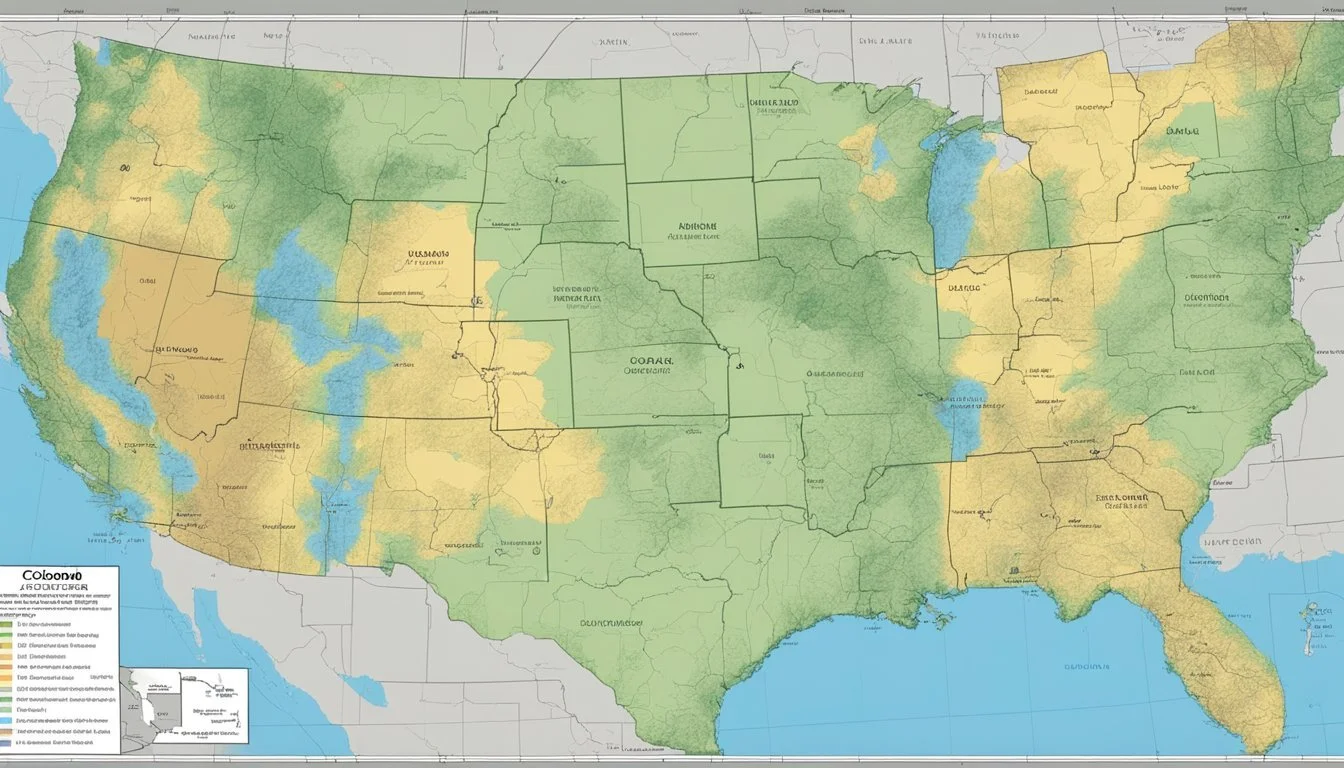USDA Hardiness Zones in Colorado
Navigating Planting Success in the Centennial State
Understanding the intricacies of the USDA Plant Hardiness Zone Map is crucial for gardeners and growers in Colorado. This map, updated in 2023, provides an essential guide to determining where various perennial plants are most likely to thrive across the state. It takes into account the average annual extreme minimum winter temperature, dividing the landscape into zones that are indicated by 10-degree F and 5-degree F increments. These zones are key to successful plant selection and garden planning, ensuring that the chosen plants are suited to withstand the local climate conditions.
In Colorado, the range of hardiness zones is particularly broad due to the state's diverse geographical features. From the high altitudes of the Rocky Mountains to the arid regions of the Colorado Plateau, gardeners must pay close attention to the Colorado Interactive USDA Plant Hardiness Zone Map to select appropriate plants for their area. Since Colorado encompasses zones with winter temperatures as low as -45°F in the colder areas to zones with milder conditions, the map becomes an indispensable tool.
The revised 2023 USDA Plant Hardiness Zone Map reflects the latest climate patterns and provides a more accurate representation for Colorado's gardeners as they embark on their horticultural projects. The milder winters in urban corridors like Denver contrast with the colder mountain areas, demanding a nuanced understanding of local climates. Adapting to these zones not only increases the likelihood of gardening success but also helps in conserving resources and promoting sustainability within the state's diverse ecosystems.
Understanding USDA Hardiness Zones
The USDA Plant Hardiness Zone Map is an essential tool for gardeners and agriculturists to determine the viability of plants in specific regions. It is a definitive guide, developed by the U.S. Department of Agriculture's Agricultural Research Service (ARS), representing the climate requirements for plant survival and growth.
Origins of the USDA Plant Hardiness Zone Map
The USDA Plant Hardiness Zone Map was created as a resource to aid gardeners and growers across the United States. Its development involved accumulating a vast array of climate data to represent the average annual extreme minimum temperatures. The map provides a crucial reference for landscaping and agricultural planning, ensuring users consider the compatibility of plants with their local climates.
Understanding Zone Numbers
Understanding the zone numbers is fundamental to the use of the map. The map divides North America into 10-degree F zones based on average minimum winter temperatures. These zones are further refined into 5-degree F half zones to provide more detail. For example, Zone 5 can be split into Zone 5a and Zone 5b, where Zone 5a represents colder areas with temperatures ranging from -20°F to -15°F, and Zone 5b represents areas with temperatures ranging from -15°F to -10°F.
Interpreting the Plant Hardiness Zone Map
Interpreting the Plant Hardiness Zone Map involves matching the zone number designated for a region with that of plant labels and seed packets. When a plant is labeled as suitable for Zone 6, it means that it can survive the winter temperatures typical of Zone 6. This strategic approach assists in selecting plants that have the best chance to thrive given the local climate conditions, and it highlights the importance of understanding one's hardiness zone to make informed planting decisions.
Colorado's Climatic Factors
Understanding Colorado's climatic factors is crucial for any agricultural planning and gardening. The state experiences a myriad of weather patterns influenced by its varied topography and altitudes.
Influence of Elevation on Plant Growth
Elevation is a defining feature in Colorado, affecting its climate and consequently, plant hardiness zones across the state. As altitude increases, temperatures typically drop, impacting the length of the growing season and the types of plants suitable for cultivation in these areas. For instance, Colorado's mountainous regions experience cooler temperatures, which can limit gardeners to plants that thrive in these conditions.
Temperature Variations and Microclimates
Distinct temperature variations are characteristic of Colorado's climate. The state is home to numerous microclimates due to significant fluctuations in geography, such as valleys and slopes, which can result in isolated areas where temperatures differ notably from surrounding regions. These microclimates are paramount to understanding which plants will flourish in a particular location.
Impact of Wind and Weather Conditions
Moreover, the wind and prevailing weather conditions have a notable impact on plant viability in Colorado. Areas exposed to strong winds may require windbreaks or hardier plant species, while regions close to a weather station might provide more accurate local data that is crucial for making informed planting decisions. With the diversity of weather conditions across the state, gardeners must consider local wind patterns and historical weather data when planning their gardens.
Navigating the USDA Hardiness Zones in Colorado
The USDA Hardiness Zones are crucial for gardeners and farmers in Colorado, as they guide planting decisions based on local climate conditions. Understanding these zones helps with selecting the right plants that will thrive in Colorado's varied climates.
Hardiness Zones of Major Colorado Cities
Colorado Springs: Located in Zone 5b, gardening in Colorado Springs requires plants tolerant to temperatures as low as -15 to -10°F.
Denver: Denver is classified within Zone 5b, similar to Colorado Springs, indicating a need for cold-hardy plant selections.
Columbine: This area falls into Zone 5b, sharing temperature considerations with other major cities in Colorado for plant hardiness.
Here is a list of other major Colorado cities and their respective USDA zones:
Boulder: Zone 5b
Fort Collins: Zone 5b
Pueblo: Zone 6a
Adjusting Gardening Strategies for Colorado's Zones
For gardeners in Colorado, adjusting strategies according to the local USDA plant hardiness zones is imperative. In cities like Colorado Springs, selecting plants that can withstand cooler temperatures is vital for successful harvesting. Gardeners should implement strategies like:
Mulching: To protect root systems during colder months.
Choosing native plants: That are adapted to Colorado's specific zones for better growth and resilience.
Paying attention to microclimates: Within your garden, which may impact how plants respond to the climate compared to the general zone categorization.
By applying strategies tailored to their specific zone, Colorado gardeners can ensure their gardens are both beautiful and bountiful.
Practical Gardening in Colorado
Colorado's varied climate necessitates specific considerations for gardeners, such as choosing appropriate plants and understanding seasonal changes. Detailed guides and the USDA Plant Hardiness Zone Map are vital tools for success.
Selecting Plants for Colorado Gardens
When selecting plants for Colorado gardens, it's crucial to consider the diverse climatic regions within the state. Colorado spans a range of planting zones, from Zone 3a, where tough perennial plants must withstand cold temperatures as low as -40°F, to Zone 7b, favorable for a variety of trees and flowers that require milder conditions. Gardeners must rely on local nurseries and use the updated USDA Colorado plant hardiness zones map to make informed decisions about which plants have the best chance to thrive in their particular zone.
Gardening Tips for Different Colorado Zones
Differing zones demand tailored gardening strategies:
Zones 3a to 4b: Consider cold-hardy options like coniferous trees and hardy shrubs.
Zones 5a to 6b: A wider range of deciduous trees and perennial flowers can be incorporated.
Zone 7a to 7b: Suitable for growing heat-loving plants such as tomatoes and many ornamental flowers.
Gardeners should focus on plants that are well-adapted to their zone's temperature extremes. Utilizing interactive Colorado USDA Plant Hardiness Zone maps can help in identifying the specific zones and corresponding planting options.
Seasonal Considerations for Colorado Gardeners
In Colorado, seasonal shifts play a pivotal role in garden planning. Understanding the average first and last frost dates is essential for timing planting and harvesting activities to avoid damage from cold weather. Season-extending techniques such as using cold frames or selecting perennial plants for early blooms can be particularly advantageous. Gardeners must stay vigilant with the ever-present possibility of late spring or early fall frosts, especially in the higher elevation zones. Regular consultation of a comprehensive guide to Colorado gardening zones can ensure that the timing of planting and maintenance aligns with seasonal norms for optimal garden health and productivity.
Tools and Resources
Gardeners and agriculturists can utilize several tools and resources to accurately determine the USDA Hardiness Zones in Colorado. These resources provide valuable information for selecting plants suited to the climate of specific regions within the state.
Utilizing the USDA's Interactive GIS-Based Zone Map
The USDA's Interactive GIS-Based Zone Map is a sophisticated tool that allows users to visually determine the hardiness zone of their area. By leveraging a Geographic Information System (GIS), this map offers detailed and accurate depictions of zones based on temperature extremes. Broadband internet connection is recommended to ensure seamless interaction with the map’s features.
Finding Your Zone With Zip Codes and the Search Box
For a quicker determination of one's local USDA Hardiness Zone, users can enter their zip code into the search box available on gardening websites. This simple method provides an immediate response, pinpointing the zone without the need for complex navigation, thus making it an efficient tool for both novice and experienced gardeners.
Accessing Local USDA Cooperative Extension Resources
Local USDA Cooperative Extension offices are invaluable resources for gardeners seeking region-specific advice. By offering updates and insights into the USDA Hardiness Zone Map, these offices provide expertise that complements the online tools. Gardeners can benefit from the face-to-face guidance tailored to Colorado's diverse climate zones.
The integration of these tools and resources ensures gardeners and agriculturists are well-equipped to make informed decisions about plant selection in Colorado's varying climate zones.
Case Studies and Zone Information
This section provides insight into the specific plant hardiness zones across various Colorado locations and highlights the successes local gardeners have found in these diverse climates.
Detailed Zone Information for Specific Colorado Locations
Alma: In Alma, gardeners face the challenges of Zone 3a, where the extreme minimum temperatures can plummet as low as -40°F to -35°F. Cultivating hardy perennials and cold-tolerant vegetables is essential here.
Aspen: Aspen's Zone 4a classification indicates a slightly milder climate with extreme minimum temperatures ranging between -30°F to -25°F. Local flora adapted to this range include native wildflowers and conifers.
Boulder: With Boulder situated in Zone 5b, temperatures drop to -15°F to -10°F. The city's gardeners enjoy a diverse planting palette, including deciduous trees, shrubs, and various perennials.
Aurora: Aurora's Zone 5b permits a range of plantings similar to Boulder's, and gardeners have successfully grown a variety of shade trees and flowering perennials that thrive in this zone.
*Italicized locations indicate a transition zone, meaning gardeners should be mindful of variations within the area.
Location
Ault
Carr
Cascade
Cedaredge
Center
USDA Zone
5b
5a
5a
6a
4b
Extreme Minimum Temp Range
-15°F to -10°F
-20°F to -15°F
-20°F to -15°F
-10°F to -05°F
-25°F to -20°F
Success Stories from Colorado Gardeners
Cimarron: A gardener in Cimarron reports thriving lavender fields in Zone 5b, which have become a local attraction, showcasing the potential for successful horticulture in cooler climates.
Cortez: Corn and bean varieties have seen great results in Cortez's Zone 5b setting as individual gardens leverage the native soil and climate conditions to support these crops.
Cottonwood: Embracing Zone 5a, residents have created resilient individual gardens that provide fresh produce and beautiful landscapes despite the challenging cooler temperatures.
Craig: One particular success story involves a communal garden in Zone 4b Craig, where efforts by the community have resulted in a bountiful harvest that includes root vegetables and cold-hardy greens.
Casual exchanges of planting techniques among these communities reinforce the understanding that meticulous selection of plant varieties suited to the Coloradan climate is key to individual garden success.
Frequently Asked Questions
Understanding USDA Hardiness Zones is crucial for gardeners in Colorado seeking to improve their planting outcomes.
What are the USDA Hardiness Zones for various regions within Colorado?
Colorado's climate varies significantly across the state, resulting in a range of USDA Hardiness Zones from 2b in mountainous regions to 7a in some parts of the southwest. Information on the zones can be found on the USDA Plant Hardiness Zone Map.
How can I find the specific planting zone for my zip code in Colorado?
To find a specific planting zone for a Colorado zip code, gardeners can utilize the interactive map available on the Plantmaps website, which provides detailed zone information based on location.
What is the range of hardiness zones found throughout Colorado?
Colorado's diverse topology includes hardiness zones ranging from very cold areas at 2b to milder regions classified as zone 7. These variations reflect the state's unique geographical features.
How do the hardiness zones in Colorado Springs compare to other areas of the state?
Colorado Springs is generally classified within USDA Hardiness Zone 5b, which is warmer than the mountainous regions but cooler than the lower elevation areas in the southwest.
What are the primary differences between adjacent hardiness zones, such as 5a and 5b?
The primary differences between adjacent hardiness zones, such as 5a and 5b, are their average annual extreme minimum temperatures, differing by about 5 degrees Fahrenheit. These nuances can affect which plants are likely to thrive.
How can I use the USDA Hardiness Zone Map to inform my planting strategy in Colorado?
Gardeners can use the 2023 USDA Plant Hardiness Zone Map to determine the most suitable plants for their region by matching their zip code's zone with the recommended zones listed for various plants.





